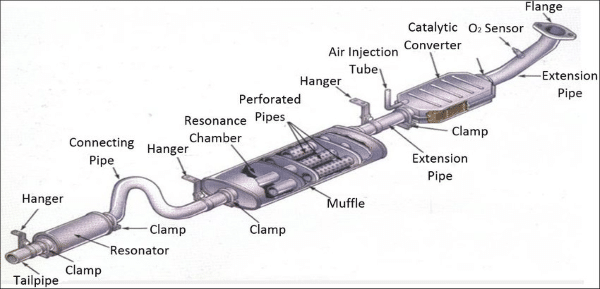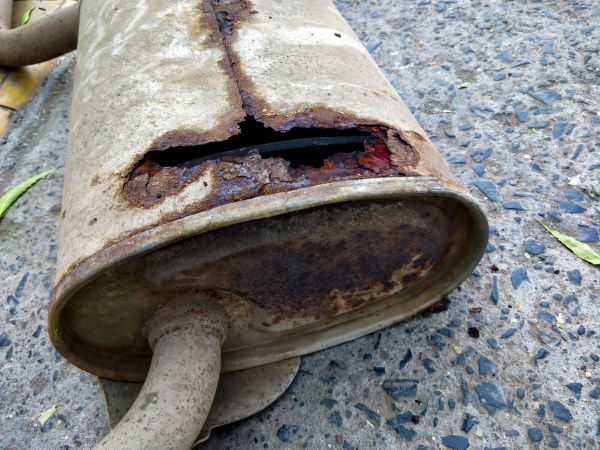Your car’s exhaust system is made up of many parts that reduce emissions. If your exhaust isn’t working right, the gases could end up in the vehicle and threaten your life. These gases are invisible and odorless, so you aren’t going to notice them. That’s why you must recognize the top exhaust leak symptoms.

We evaluate the exhaust system, identifying all of the parts. We also review the symptoms that point to a leak, show you what might have caused it and teach you how to perform an exhaust pipe repair.
Table of Contents
What Does an Exhaust System Do?
The exhaust system is a combination of connectors, pipes, mechanical devices and sensors that dispose of the fumes resulting from the motor’s combustion. The main function of the exhaust system can be broken down into three parts.
- Funnels gases away from the cabin
- Quiets noise created from the engine’s combustion process
- Cleans the fumes that are harmful to the environment

Parts of the Exhaust System
The majority of exhaust system parts will be made from steel to handle the stresses that occur under the vehicle. Moving from the engine to the back of the car, here are the components that make up the exhaust.
Exhaust Manifold
The manifold is bolted directly to the motor. Its main job is to collect exhaust gases coming from the cylinders so they can be funneled into one tube.
Catalytic Converter
The catalytic converter cleans out the exhaust. It reduces harmful fumes that come from the engine. The cat contains special catalysts to convert nitrous oxide, carbon monoxide and hydrocarbons into other byproducts that won’t hurt the environment. Some of these include nitrogen, carbon dioxide and water vapor.
Resonator
The resonator works like an echo chamber, changing the tone of the engine while the gases are flowing through it.
Muffler
The muffler is at the end of the exhaust system. It mutes loud noises that are created by the engine.
Tailpipe
The tailpipe finishes off the muffler. It’s the last stop for the exhaust gases before they are sent into the air. Some vehicles feature several tailpipes for better exhaust flow and a heightened appearance.
Connecting Pipes
You will find connecting pipes throughout the exhaust system, holding various components together.
O2 Sensors
The oxygen sensors analyze the exhaust gases and tell the ECU how to make the air/fuel mixture right.

5 Exhaust Leak Symptoms to Watch For
While there is not an exhaustive list of symptoms you might encounter, these are the top five complaints you will notice.
1. Exhaust Leak Sound
If you start the car’s engine and hear a loud noise coming from the motor, it might be the sign of an exhaust manifold leak, possibly due to a worn gasket. The gasket is situated between the manifold piping and the engine block, so it is always subject to heat, which can cause it to fail over time.
If an inspection of the manifold itself doesn’t reveal a leak or crack, you want to check the gasket.
2. Gas Pedal Vibrates
If a leak occurs, the vehicle will start to vibrate. However, when that leak becomes larger, you will have no trouble feeling the vibrations. The first vibration might be felt in the gas pedal and eventually move to the steering wheel. If the situation is dire, the floorboards might even be rattling.
3. Decreased Fuel Economy
Keep an eye on your fuel economy to see how efficient your vehicle is. If you are noticing more frequent stops at the pump, it could be due to a leaky exhaust. As the system leaks, the engine becomes less efficient, thereby reducing the fuel economy.
4. Whistling During Acceleration
While we discussed loud noises coming from the system, you also want to be aware of whistling or the sound of air escaping. It might occur most pronounced when you step on the accelerator.
However, it’s often difficult to differentiate between a leaky exhaust and other engine noises. Sometimes, these also produce a similar tone to a vacuum hose leak.
5. Strange Odors
The only exhaust fume that is odorless is carbon monoxide. If the exhaust manifold is leaking, you might notice odors from the other gases. Any time that this occurs, you should stop driving your vehicle. After all, you don’t want to breathe in these harmful fumes.

Exhaust Leak Causes
So, what causes the exhaust system to leak in the first place? There are several reasons, including:
Physical Damage
The exhaust sits under the car, so it endures a lot of abuse. Even if you are a perfect driver, you are going to encounter potholes and road hazards that could damage the exhaust.
Corrosion
Because of the placement of the exhaust, it also deals with temperature changes and precipitation. While the stainless steel material can take a lot of abuse, it’s not bulletproof. Over time, the system might start to rust or corrode.
Defective Gaskets
The exhaust system contains gaskets that help to seal it. However, these gaskets can also break down as they become older. When this happens, the uneven surfaces allow room for a leak to occur.
Poor Welding
If you’ve recently had the exhaust repaired and there is a leak, it could be caused by shoddy work.
Old Age
Nothing on your car will last forever. After many years of hard work, the exhaust system might fail you for no reason other than it is old.
How to Find Exhaust Leak
Finding an exhaust leak isn’t always easy. However, we have some tips that might lead you in the right direction.
Use Your Senses
You can feel some exhaust leaks or use your ears to spot one. Allow your car to completely cool down, then follow these steps.
- Turn on the vehicle.
- Listen to various parts of the system to find the leak.
- Run your hand along the system to see if any air is coming out.
You should start at the engine where the exhaust begins and work your way back. If you can convince a friend to rev the engine while you do this, you might have an easier time.
Use a Rag to Create a Blockage
If you find nothing after that simple check, consider following these steps next.
- Cool the car down once again.
- Block the tailpipe with a rag.
- Start the car and search again for the leak using the method above.
Because the air can’t escape out the tailpipe, you might be able to find the leak a little easier. More air should be forced out through the leak location, making it simple to spot.
Use Soapy Water
If you find nothing after doing those steps, follow this method instead.
- Allow the car to cool down.
- Mix soap and water in a spray bottle.
- Spray potential problem areas with your solution.
- Turn the car on.
- Watch for air coming from the leak point. They will show up as bubbles or you might notice foaming.
Buy a Smoke Machine
For a reasonable amount of money, you can buy a smoke machine, which will show you where the leak is. The machinery sends smoke into the exhaust system. You will see it coming from the leak location.
- Test Evap/Vacuum leaks, Easy to use, simple to read instructions
- Made In USA,Quality made
- Great tool to have for automotive leaks, Uses Mineral oil
- Fraction of the cost as commerical Evap Machines
- One the most valuable tools for any one that works on cars testing for Evap and Vacuum Leaks!
Put a Shop-Vac in the Exhaust Pipe
This method should only be used after doing your own research as some mechanics think it could be dangerous to the vehicle.
- Clean out your Shop Vac.
- Attach the suction tube to the blower outlet, creating a reverse effect.
- Put the hose into the tailpipe.
- Turn on the Shop Vac and listen for a leak.
- VERSATILE: Ideal for medium-sized jobs around the garage, home, renovations, and jobsite
- BLOWER PORT: Use the rear exhaust port on this shop vacuum for blowing debris out of your garage or from your driveway and sidewalk
- OVERSIZED DRAIN: Built-in oversized drain on the wet/dry vac allows for convenient emptying of liquids
- EASY FILTER REPLACEMENT: Qwik Lock Filter Fastening System allows quick and easy wet dry vacuum filter changes
- ACCESSORIES INCLUDED: 1-7/8 in. x 7 ft. POS-I-LOCK Hose, 2 Locking Extension Wands, Utility Nozzle, Car Nozzle, Wet Nozzle, Qwik Lock Filter and Dust Collection Bag
Ideally, this will exaggerate the problem so you can find it easier. However, air was never meant to be blown into the exhaust system. You could end up with contaminants in the engine, thereby causing more problems than you started with.
Some of this information is further explained in this helpful YouTube video.
How to Fix Exhaust Leak
Dealing with an exhaust repair looks differently based on where the leak is and how severe it has become. We will deal with some of the most common exhaust leak repair steps you could face.
How to Perform an Exhaust Manifold Repair
If the leak is coming from the manifold or one of the many joints, you may be able to seal it. At first, you might just try a product, such as J-B Weld 37901 ExtremeHeat High Temperature Resistant Metallic Paste. It’s considered the best exhaust sealant and offers an easy solution to some leaks.
- Jb Weld Extreme Heat: Is Formulated For Repairs To Iron, Steel And Metal In High Temperature Environments 1000°F / 537°C. Non-Flammable, It Contains No Solvents Or Volatile Organic Compounds (Vocs).
- The Original Cold Weld: Jb Weld Was Developed As An Alternative To Torch Welding. Designed To Be Effective In Extreme Environments, Once It Sets, It Creates A Permanent Bond Stronger Than Steel.
- Simple To Use: When Fully Cured, This Metallic Compound Can Be Drilled, Machined Or Sanded. It Is Great For Repairing Cracks, Small Gaps, Seam Connections Or Holes.
- Versatile & Dependable: Ideal For Repair Work On : Exhaust Manifolds, Pipe Connections, Mufflers, Catalytic Converters, Outdoor Grills, Fire Boxes, Gas And Commercial Furnaces And Water Heaters.
If that doesn’t work, you might need to change the manifold gasket. Or, look at the joints, which all contain gaskets. While these should be easy fixes as well, there are times when the bolts can become rusty, making them more difficult to remove without a little elbow grease.
Here’s a helpful video showing you how to repair a manifold gasket.
How to Repair a Hole or Break in the Exhaust System
It’s your worst nightmare – finding a hole or break in the system. While your heart might sink at first, you don’t need to panic. Sometimes a cracked manifold or broken tailpipe can be fixed at home.
Some people choose to use a muffler repair kit, such as the Permatex 80334 1000 Degree Plus Exhaust Repair Kit. This product can be used as a muffler patch, but it doesn’t always work. However, for the cost, it’s worth a shot.
- These Are Complete Line Of Heavy-Duty Shop Products
- Through Creativity, Productivity And Innovation - This Brand Continues To Develop The Finest Automotive Accessories
- Suggested Applications: Mufflers and tailpipes on automobiles, trucks, tractors and farm equipment
- Kit contains ready-to-use foil-packed bandage and support wire
Some holes and breaks can be more difficult to fix. In some cases, you will need to replace the section of exhaust or pipe. This process involves removing the two closest joints and fitting in a new section. Not only will this exhaust repair likely be expensive, but you might also have to deal with rusted connections and bolts.
Ideally, you would take your vehicle to a muffler repair shop so the new component could be welded in place. This is the only way to guarantee that the exhaust system will remain leak-free.
Here’s a YouTube video showing how to replace the muffler.
How to Save Money on an Exhaust Leak Repair
Once you get a quote on the exhaust leak repair, you might start searching for some money-saving tips. Thankfully, there are some ways to save on the expense.
First, attempt the repair yourself. If you are mechanically inclined, you might be able to perform the fix yourself. Most exhaust leaks aren’t complicated repairs unless the parts are difficult to get to or the bolts are rusted in place. If you buy the parts yourself and install them, you could save a lot of money.
If you aren’t sure you can take on that kind of work, consider at least buying the parts yourself. However, you want to check with your mechanic to make sure this is allowed. Some mechanics will force you to purchase the parts through them.
Exhaust Leak FAQs
Can I drive with an exhaust leak?
You might be tempted to drive with an exhaust leak, especially if it isn’t serious. However, you should avoid this practice at all costs. Driving with any exhaust leak is dangerous because the gases contain carbon monoxide, which can quickly kill you if it seeps into the cabin.
What is the exhaust leak repair cost?
Exhaust repairs can be expensive, especially if you are dealing with a complicated manifold leak. If you plan to take your vehicle to a professional shop, plan on spending $200 or more, depending on what parts are needed and how long the labor will take.
Can I learn how to fix an exhaust pipe without welding?
There are ways to repair your exhaust leak without welding in a new piece. This is most often done when the muffler needs to be replaced, with the help of exhaust clamps. However, this process isn’t often worth your effort, as you will probably need to weld it anyway. If you do choose to use clamps, make sure you buy the right size for your pipe, which should provide a usable seal, even if it isn’t as secure as welding.
If my car leaks gas, is this one of the exhaust leak symptoms?
Probably not. If the car is leaking gas it might be due to a defective vent hose, fuel injector, fuel pressure regulator, a gas tank cap or fuel line. However, your fuel tank might also have a hole in it, causing gas to spill on the ground. You should never drive a car with a fuel leak.
What does danger to manifold mean?
At first glance, this might look like a mechanical term that only professionals understand. However, the saying actually points back to The Fast and The Furious movie. In this film, Paul Walker’s character is racing Vin Diesel when the “Danger to Manifold” warning appears, advising him to avoid powering up any more NOS. Since that movie’s release, the term “Danger to Manifold” has taken on a slang meaning, basically saying that something will make you blow your gasket or it’s hard to swallow.
Conclusion
No one wants to deal with any of the common exhaust leak symptoms, but it happens. Knowing what you are looking at and figuring out how to fix your problems can make it less painful. When in doubt, visit your local repair shop for more guidance.




